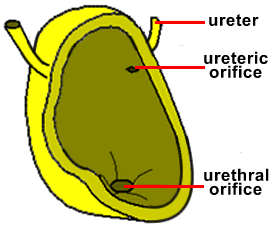Bladder
Arterial and Venous supply
Superior and inferior vesical arteries off internal iliac arteries. Veins form vesical venous plexus, which, in the male, communicates with the prostatic plexus, it is drained into the internal iliac vein.
Lymph vessels
Drains into the internal and external iliac nodes.
Nervous Supply
Comes from the inferior hypogastric plexuses.
Sympathetic
Inhibit contraction of the detrusor muscle of the bladder wall, and stimulate closure of the sphincter vesicae
Parasympathetic
Stimulate contraction of the detrusor muscle, and inhibit action of the sphincter vesicae.
Structure
The empty bladder is pyramidal, with an apex and a base. It is usually below the level of the pelvic inlet unless full. Max capacity is about 500ml. Urine drains into the bladder from the kidneys via the ureters, which insert at each corner of its base. The urine then drains into the urethra through the neck of the bladder. The walls of the bladder have a 3 layered smooth muscular coat, called the detrusor muscle. At the neck of the bladder, the circular layer of fibres is thicker, making a sphincter, called the sphincter vesicae – this stops the wee leaking out.
Function
Micturation (weeing) is a stretch reflex. When the amount of urine reaches about 300ml, stretch receptors in the bladder wall send messages to the CNS. The efferent impulses causes the detrusor muscle to contract, and the sphincter vesicae to relax. The urethral sphincter also relaxes.
In infants, this process acts as a simple reflex, and happens whenever the bladder is distended. In the adult, the cerebral cortex inhibits the reflex until the right moment – the person gains a conscious desire to wee.
Clinical Conditions
Cancer
Now, there is a difference between medicine in practice and medical school. For example, in the real world, very rarely will one have a patient presenting with a history of a lifetime working in the rubber industry as a helpful clue that they have bladder cancer. Life isn't usually that easy.
However, I guarantee you, if bladder cancer comes up in an exam, the patient will probably be called Mr R, will have worked since he was 6 in rubber dyeing, and will probably be wearing rubber clothes and have a body made entirely of blue dyed rubber. Okay – it won't be that obvious, but hear anything in a history saying rubber and think transitional cell carcinoma of the bladder.
Like many cancers, smoking is also the highest risk factor.
Cystitis
Inflammation of the bladder. The organism causing the response is usually from the patient's faecal flora, although sometimes it can be caused tuberculosis bacteria.
It presents with abdominal pain and dysuria (pain on weeing), and sometimes haematuria.
It is important because that it can lead to pyelonephritis.
Calculi
Stupid word for stones – it's the latin for "pebble". May pass down from kidneys, or form in bladder. Fairly typically cause chronic irritation, and increased frequency, urgency, dysuria and sometimes haematuria.
